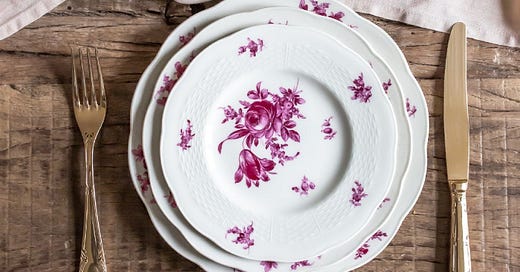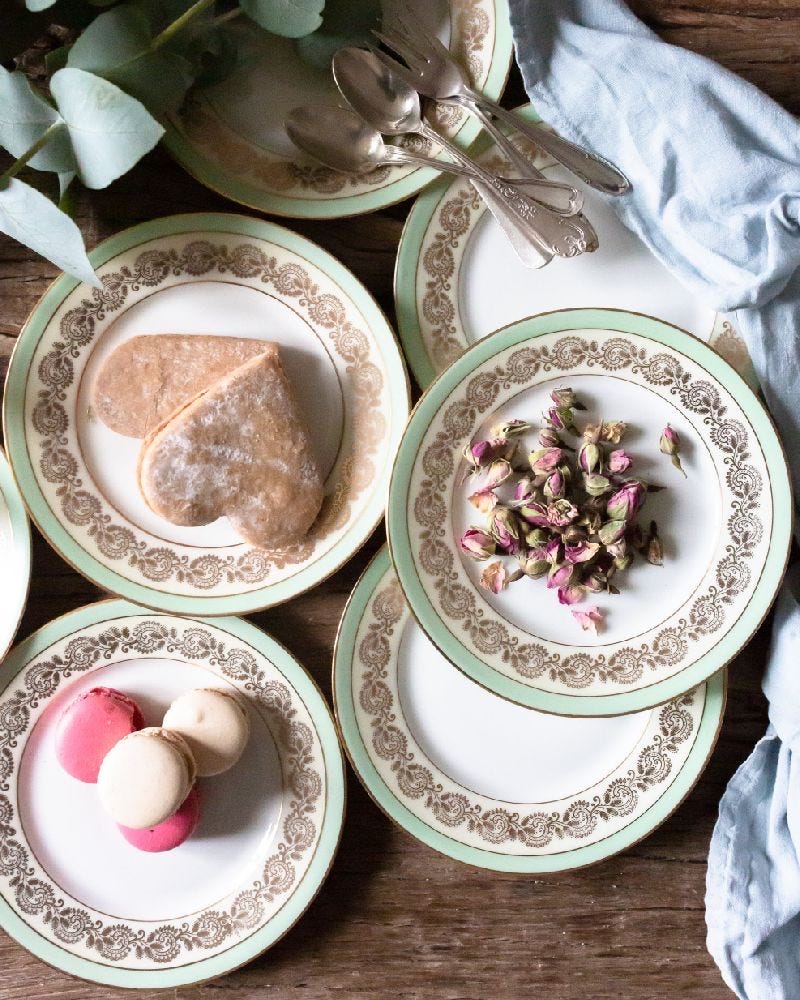A Case For The Good China
Resharing why every day is special enough to use and do what you love.
I first shared this post on Madame de la Maison’s blog in the thick of the pandemic in 2020 and then a shorter and edited version in my book JOIE. I know many of you have already read it, but I want it to live here on this Substack.
A question I am often asked by journalists or on podcasts is why did this post resonated so strongly with people? Why did it lead to me writing a book? The answer is because the good china is a metaphor for so many other things and moments of our lives. I believe that you should surround yourself with objects that bring you joy and actually use them! Like seriously actually use them and not keep them locked away in a cabinets, closets or on shelves. I spoke strongly about this on David Lebovitz podcast and found it fun that he actually pulled out things he treasured but couldn’t bring himself to use for fear of their demise.
However I remind you that my message on not waiting for a special occasion to use “the good china” should apply to wearing clothes you actually like, inviting friends over for a lunch and not worrying about perfection, taking a day or a weekend off away from work to do something that brings you joy, and any fill in the blank of seizing moments, consuming dreams, or leaning into your desires that bring will bring you joy. Don’t wait.
If you have never read A Case for the Good China, I invite you to dive in. (If for any odd reason you want to read the longer and original version of this story you can read it here. But I know our time is precious so below is a tighter edit.) And if you have read it maybe hop over to the comments to share what spoke to you about this story. In any case thank you for letting me share it again.
Growing up a skinny, knob-kneed Nigerian girl in Austin, Texas, during the 1980s, prime time television was my sacred source of education to be more “American.” I loved watching family television shows like Fresh Prince of Bel Air, The Cosby Show, Family Ties, and Full House. My two brothers and I would spend hours lying in front of the TV with our chins propped up on our knuckles and our eyes glued to the screen.
I picked up style tips and new words from the kids in those shows, and learned how families in America functioned. They were interesting because they were so different from mine—especially during dinner time. All the kids and their unforgettable quirky friends named Cockroach, Jazzy, Cornflake, Kimmy Gibbler, and of course, Steve Urkle, never passed on the chance to join a group at the set table. Occasionally, an oddball relative would also pop in for dinner and a lively conversation would ensue.I loved the joy, conviviality, and the swell of emotions that came to the table. There was something special about all the people sitting together talking, laughing, and sharing thoughts. I treasured the mixed generations and personalities as well as the friendships, the big reveals, and even the denouncements.
As a child, I appreciated the beautifully orchestrated chaos of different arms reaching across pretty china strewn about a lovely tablecloth. I wanted to mimic the adults who clinked shiny silver cutlery to a crystal glass before an announcement. And I remained fascinated by the ritual of slapping a fabric napkin down and storming off as a means for declaring drama.
Things at my house looked a bit different than what I saw on TV. When I came home from school, a giant pot with some strongly-scented Nigerian dish was usually sitting on the stove, demanding my name. While we had extra family members floating in and out of our homes, none of our American friends wanted to stay for dinner since we weren’t serving any American classics.
When hunger crept up, I would walk past my mother’s darkwood cabinet of treasured china on my way to the kitchen. It was full of shiny things I was forbidden to touch. Through its glass doors I could see ceramics and antique finds from my mother’s Saturday garage sale trips as well as her precious wedding china. Half of it was on display, and the rest of it was nicely packed away in padded containers. The drawers that pulled out were velvet-lined with shiny sets of elegant flatware adorned with gold accents running along the handles.
These treasures haunted me on that daily walk to the kitchen because I was instructed to take tupperware instead. Routinely, I asked, “Mommy, when can we set the table with the pretty china plates?” Her response was always the same: “Not today. I’m waiting for a special occasion.” I never gave up asking, and she stayed true to her response.
One year, we were hosting Easter with many of our Nigerian friends from church. I figured this would be classified as a special occasion. (Nevermind that Nigerians gather to celebrate darn near everything, including a 10-year-old’s graduation to middle school. I reminded my mother, while wearing a pastel-colored, frilly version of my Sunday best, that it was Easter, which means the Lord has risen and that is a special occasion. As a devout Christian, she couldn’t deny my liturgical reasoning and granted my wish. (Maybe the dress helped?)
Together, we set our table for 12 people and it was a glorious ritual that I will never forget. I joined my mother in setting a plate in front of each chair and placing the appropriate cutlery beside each plate. I followed my Mom’s naturally graceful effort, placing the items slowly and ceremoniously to savor this moment she was sharing with me. After we were done, we stood back and looked at the table together. It was marvelous. I immediately became lost in imagining my TV sitcom moment. (But I ignored the part when an Easter ham would sit on the table next to fried goat meat and foofoo.)
Eventually, I was brought back to the present by the sound of my mother clearing the table and returning my porcelain dreams to her precious cabinet. What in the world was she doing? I watched in horror. This new reality was all the more confirmed when she closed those dark wooden doors and the china disappeared behind the ivory knob. She told me she ended up not wanting to use these for Easter lunch because someone would probably break them, so instead we had lunch with our guests on paper plates and the primary-colored tupperware.
I was devastated, but I never gave up asking to set the table like that again. Still, her response remained equally unwavering: She was waiting for a special occasion. Sadly, this never came and my mother passed away when I was 12 years old. Only a week before, perhaps sensing her time was nearing its end, she pulled me into her room and told me that soon all the beautiful china would be mine and I could set the table whenever I wanted. This remains one of my saddest, but most vivid memories and the impetus for me to always use “the good china” because my mother never did.
I promised myself I wouldn’t make the same mistake and neither should you. Every day is worthy of “the good china” and all the pretty pieces you buy. (And the good china can truly be a metaphor for anything that you love.) You may have chosen them for their beauty or story and, therefore, they bring you joy. So what are you waiting for? You deserve to use them. You're also offering someone a gift when you share your treasures and welcome them to your table. Why buy antiques and special pieces only to lock them away in a dark cabinet? Whether, like the sitcoms of my childhood, you want to bring people together for memorable moments or you're just enjoying a quiet dinner alone, these occasions are deserving of your best pieces.
Don't be like my mother and wait for a day that may never come. Every day is a special occasion, so bust out all your table treasures.
*Excerpt from JOIE: A Parisian’s Guide to Celebrating the Good Life (Clarkson Potter, April 2023)





